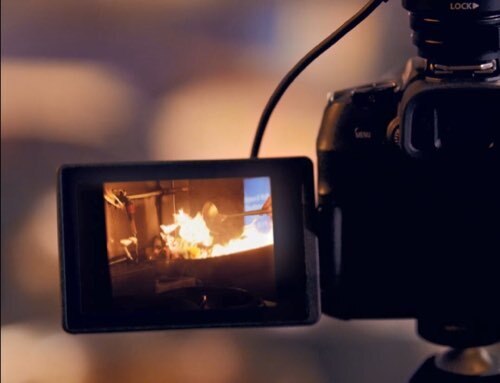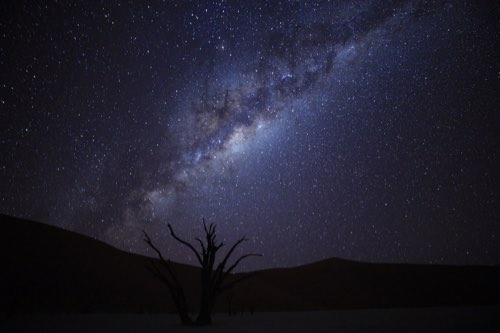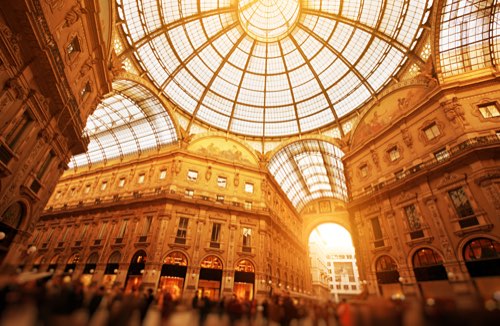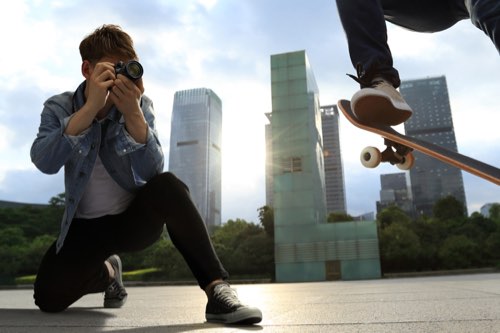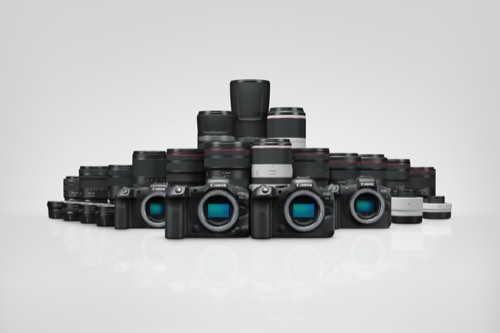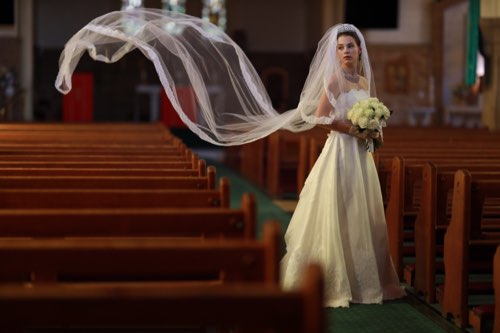Taking your new camera on a walkabout in the city? Here are some in-camera functions that will help you capture fleeting moments and achieve cool, edgy images shareworthy straight out of the camera! (Reported by: Teppei Kohno)

FL: 18mm (29mm equivalent)/ Aperture-priority AE (f/8, 1/160sec, EV -1/3)/ ISO 160/ WB: Tungsten light/ Picture Style: Fine Detail
I paid attention to the texture of the building, and set Picture Style to "Fine Detail" and WB to "Tungsten light" to give the otherwise lifeless building a dramatic finish.
1. Use Creative Filters to add artistic flair to your photos
Street and city scenes make great Creative Filter subjects
Exploring artistic possibilities? If your camera comes with Creative Filters, you should definitely try to use them when shooting cityscapes.
Unlike natural landscapes, common urban elements like buildings, signboards, and roads have clear forms, which makes the effects appear more obvious on them. Typical examples of Creative Filters you can use for city scenes are ‘Miniature effect’, which makes the image look like a miniature model, and the ‘Fish-eye effect’, which captures the image with a barrel-shaped distortion.
Other Creative Filters to try include the different HDR (High Dynamic Range) effects, which automatically merge three shots of the same scene taken at different exposures into one image.

FL: 16mm (26mm equivalent)/ f/5.6/ 1/60 sec/ Creative filters: Miniature effect/ ISO 160/ WB: Auto/ Picture Style: Standard
In the example above, I used ‘Miniature effect’ to capture the person as a silhouette and boldly blur out the background for dramatic results. This is an example of how Creative Filters can add impact even to a shot of an ordinary scene.
Tip: If you are using a DSLR, shooting with the rear LCD monitor lets you preview the Creative filter effects. On mirrorless cameras like the EOS M50 Mark II, you can also do the same via the electronic viewfinder (EVF).
Using the ‘Miniature effect’ Creative Filter
1. Set the Mode Dial to [Creative Filters](A), and then press [Quick Set menu](B).

2. Select [Miniature effect](C) from the menu that appears.

3. The area marked by two horizontal lines (in the blue circle below is the scene frame. Elements in this frame will appear in focus while those outside it will appear blurred. To change the position of the frame, tap the icon at the bottom right of the screen (shown in the red box).
(If you are shooting through an EVF, you can press a button to activate the adjust miniature effect frame position tool. It depends on your camera, so follow the instructions onscreen!)
4. The miniature effect frame will turn orange. Press the up/down control keys or tap the screen to shift the frame.
To change the orientation of the frame, either tap the icon shown in red, or press the left/right control keys. Press the [INFO] button to return the frame to the centre. Press [SET] to confirm the position.
5. When the scene frame is in the vertical orientation, you can move it using the left/right arrows.
2. Configure custom shooting modes for quick access to your favourite settings
Makes capturing unexpected shutter opportunities so much easier
When shooting in the streets, you will probably come across many scenes that you intuitively want to capture. Pace and timing are important—every moment spent adjusting camera settings could mean a photo opportunity lost!
This is where custom shooting modes (C1, C2, and depending on camera model, C3) are invaluable. They enable you to store your most commonly used shoot settings for easy recall with a turn of the mode dial.
For example, for this shoot, I registered the Program AE mode, Picture Style (Landscape), and some other detailed settings into the C1 slot, and recalled it whenever I encountered a scene with more vivid greens. I set my C2 slot to recall Picture Style (Monochrome).

FL: 17mm (27mm equivalent)/ Program AE (f/10, 1/200sec)/ ISO 100/ WB: Daylight (A1, G2)/ Picture Style: Landscape
I applied the custom shooting mode that I had registered in advance to achieve a vivid finish centred on the greenery. This allowed me to focus on the fun of composition without being constrained by the camera setup.
Configuring custom shooting modes
1. Configure your camera to the settings that you want to store.
2. Press [MENU], and in the settings menu tab [4], select [Custom shooting mode (C1, C2)].

3. Select [Register settings], and then select the custom shooting mode (C1 or C2) to be registered.

4. When you want to recall your stored settings, you just need to turn the mode dial accordingly.

Picture Styles aren’t the only settings you can save in the custom shooting modes. A bird photographer shares how he uses them here:
Bird Portraits: 4 Simple Tips for Finding a Better Angle (Bonus technique)
Also see:
Guide to Fv Mode: What It Is and How To Use It
3. Ensure perfect horizontality in your shots of buildings and structures
Display the grid lines and level
In urban photography, just like in landscape and architectural photography, it’s important to ensure horizontality and verticality so that your compositions look more stable. This is especially so if your subject has distinct horizontal and vertical lines, as even the slightest tilt would be obvious.
While you can try to straighten the image during post-processing, this will involve cropping away the edges of the image, and the results might not be what you intended. For better control over your composition, display the grid lines and level in your Live View display or EVF to get your image looking level on the spot.
Use grid lines when the subject has visible lines
The grid lines are especially effective in scenes with distinct lines. They can be displayed in 9 sections (3 x 3), 24 sections (6 x 4), or 9 sections (3 x 3) with diagonals, which you can select according to the scene.
Use the level when there are no visible lines
For scenes that don’t have obvious horizontal or vertical lines, you can display the electronic level to ensure that you are holding the camera straight and level. Of course, you can also use the grid lines in combination with the level if you wish.
Tip: Getting the horizon to look straight isn’t always about holding the camera parallel to the ground.

FL: 16mm (26mm equivalent)/ Creative filters: Miniature effect/ ISO 160/ WB: Auto/ Picture Style: Standard
I captured as silhouettes the window frames and people on an observation deck, using the grid display as a composition aid. This exactly the kind of scene where the grid display is most useful.
Using the grid lines and level
1. Press [INFO.] to display the grid lines and level.

2. Move the camera to adjust the position until the red line of the level turns green.

3. To change the type of grid, access Shooting menu tab [1] > [Shooting information display] > [Grid display].

4. You can also change the display to grid only or level only by accessing [Shooting information display] > [Screen info/toggle settings].

For more tips about photographing buildings, check out our series on architectural photography, starting from:
Architectural Photography #1: 3 Basic Concepts
For more urban photography ideas, see:
Pro Tips for Improving Your Street-level Architecture Shots
3 Beginner-friendly Ways to Spice Up Your Urban Nightscapes
One Location, Two Looks: Abstract Nightscapes – Tranquillity vs. Vibrancy
Receive the latest update on photography news, tips and tricks.
Be part of the SNAPSHOT Community.
Sign Up Now!About the Author
Born in Tokyo in 1976, Kohno graduated with a Social Work degree from the Department of Sociology of Meiji Gakuin University, and apprenticed with photographer Masato Terauchi. He contributed to the first issue of photography magazine PHaT PHOTO and became an independent photographer after that, in 2003. The author of many books, Kohno not only shoots all sorts of commercial photographs, but also writes prolifically for camera and other magazines.







